This text is featured in Bitcoin Journal’s “The Halving Challenge”. Click on right here to get your copy. It is usually report #1 of the “FUD Fighters” collection powered by HIVE Digital Applied sciences LTD.
F%$Ok Dangerous Analysis: I spent over a month analyzing a bitcoin mining research and all I obtained was this trauma response.
“We should confess that our adversaries have a marked benefit over us within the dialogue. In only a few phrases they will announce a half-truth; and with the intention to show that it’s incomplete, we’re obliged to have recourse to lengthy and dry dissertations.” — Frédéric Bastiat, Financial Sophisms, First Sequence (1845)
“The quantity of vitality wanted to refute bullshit is an order of magnitude greater than that wanted to supply it.” — Williamson (2016) on Brandolini’s Regulation
For too lengthy, the world has needed to endure the fallout of subpar educational analysis on bitcoin mining’s vitality use and environmental impression. The end result of this bullshit analysis has been surprising information headlines which have turned some well-meaning individuals into indignant politicians and deranged activists. So that you just by no means must endure the brutality of one in all these sloppy papers, I’ve sacrificed my soul to the bitcoin mining gods and carried out a full-scale evaluation of a research from the United Nations College, printed just lately within the American Geophysical Union’s Earth’s Future. Solely the bravest and hardest of all bitcoin autists might proceed to the next paragraphs, the remainder of you possibly can return to watching the worth chart.
Your comfortable child ears might need screamed with shock on the sturdy proclamation in my lede that the largest and squeakiest analysis on bitcoin mining is bullshit. In the event you’ve ever learn Jonathan Koomey’s 2018 weblog submit on the Digiconomist–often known as Alex deVries, or his 2019 Coincenter report, or Lei et al. 2021, or Sai and Vranken 2023, or Masanet et al. 2021, or… Properly, the purpose is that there’s hundreds of phrases already written which have proven that bitcoin mining vitality modeling is in a state of disaster and that this isn’t remoted to bitcoin! It’s a battle that knowledge heart vitality research have confronted for many years. Folks like Jonathan Koomey, Eric Masanet, Arman Shehabi, and people good guys Sai and Vranken (sorry, we’re not but on a first-name foundation) have written sufficient pages that would most likely cowl the partitions of at the least one males’s lavatory at each bitcoin convention that’s occurred final yr, that present this to be true.
My holy altar, which I maintain in my bed room closet, is a hand-carved, elegant but ascetic shrine to Koomey, Masanet, and Shehabi for the many years of labor they’ve finished to enhance knowledge heart vitality modeling. These sifus of computing have made all of it very clear to me: in the event you don’t have bottom-up knowledge and also you depend on historic developments whereas ignoring IT machine vitality effectivity developments and what drives demand, then your analysis is bullshit. And so, with one broad but very surgical stroke, I swipe left on Mora et al. (2018), deVries (2018, 2019, 2020, 2021, 2022, and 2023), Stoll et al. (2019), Gallersdorfer et al. (2020), Chamanara et al. (2023), and all of the others which might be talked about in Sai and Vranken’s complete evaluation of the literature. World, let these burn in a single violent but metaphorically majestic mega-fire someplace off the coast of the Pacific Northwest. Reporters, and policymakers, please, I implore you to cease listening to Earthjustice, Sierra Membership, and Greenpeace for they know not what they do. Absolve them of their sins, for they’re however sheep. Amen.
Now that I’ve set the temper for you, my pious reader, I’ll now let you know a narrative a couple of current bitcoin vitality research. I pray to the bitcoin gods that this would be the final one I ever write, and the final one you’ll ever must learn, however my feeling is that the gods are punishing gods and won’t have mercy on my soul–even in a bull market. One deep breath (cue Heath Ledger’s Joker) and Right here… We… Go.
On a considerably bearish October afternoon, I obtained tagged on Twitter/X on a submit a couple of new bitcoin vitality use research from some authors affiliated with the United Nations College (Chamanara et al., 2023). Little did I do know that this research would set off my autism so exhausting that I might descend into my very own sort of drug-induced-gonzo-fear-and-loathing-in-vegas state, and hyper-focus on this research for the following 4 weeks. Whereas I’m most likely exaggerating in regards to the heavy drug use, my recollection of this time could be very a lot a techno-colored, poisonous relationship-level fever dream. Do you bear in mind Frank from the critically acclaimed 2001 movie, Donnie Darko? Yeah, he was there, too.
As I began taking notes on the paper, I spotted that Chamanara et al.’s research was actually complicated. The paper was perplexing as a result of it is a poorly designed research that bases its raison d’etre fully on de Vries and Mora et al. It makes use of the Cambridge Middle for Various Finance (CCAF) Cambridge Bitcoin Vitality Consumption Index (CBECI) knowledge with out acknowledging the constraints of the mannequin (see Lei et al. 2021 and Sai and Vranken 2023 for an in-depth evaluation of the problems with CBECI’s modeling). It conflates its outcomes from the 2020-2021 interval with the state of bitcoin mining in 2022 and 2023. The authors additionally relied on some environmental footprint methodology that will make you assume it was truly attainable so that you can shrink or develop a reservoir relying on how exhausting you Netflix and chill. Actually, that is what Obringer et al. (2020) inferentially conclude is feasible and the UN research cites Obringer as one in all its methodological foundations. By the way in which, Koomey and Masanet didn’t like Obringer et al.’s methodology, both. I’ll gentle one other soy-based candle on the altar of their honor.
Right here’s a extra clearly said enumeration of the crux of the issue with Chamanara et al. (and by the way in which, their corresponding creator by no means responded to my e-mail asking for his or her knowledge so I might, you understand, confirm, not belief. 🥴):
The authors conflated electrical energy use throughout a number of years, overreaching on what the outcomes might reveal primarily based on their strategies.
The authors used historic developments to make current and future suggestions regardless of intensive peer-reviewed literature clearly displaying that this results in overestimates and exaggerated claims.
The paper guarantees an vitality calculation that may reveal bitcoin’s true vitality use and environmental impression. They use two units of information from CBECI: i) whole month-to-month vitality consumption and ii) common hashrate share for the highest ten international locations the place bitcoin mining is operated. Understand that CBECI depends on IP addresses which might be tracked at a number of mining swimming pools. CBECI-affiliated mining swimming pools symbolize a mean of 34.8% of the whole community hashrate. So, the info used probably have pretty large uncertainty bars.
After about an hour or so of Troy Cross speaking me off a slightly spectacular, artwork deco and weather-worn ledge that’s most likely seen a number of Nice Gatsby flappers soar–a results of feeling an awesome sense of terror after my exasperated self realized that no quantity of cognitive behavioral remedy would get me by this research–I decided the equation that the authors used to calculate the vitality use shares for every of the highest ten international locations with essentially the most share of hashrate (primarily based on the IP tackle estimates) needed to be the next:
Don’t let the maths scare you. Right here’s an instance of how this equation works. Let’s say China has a shared share for January 2020 of 75%. Then, let’s additionally say that the whole vitality consumption for January 2020 was 10 TWh (these are made-up numbers for simplicity’s sake). Then, for one month, we’d discover that China used 7.5 TWh of vitality. Now, save that quantity in your reminiscence palace and do the identical operation for February 2020. Subsequent, add the vitality use for January to the vitality use discovered for February. Do that for every subsequent month till you’ve added up all 12 months. You now have CBECI’s China’s annual vitality consumption for 2020.
Earlier than I present the desk with my outcomes, let me clarify one other caveat to the UN research. This research makes use of an older model of CBECI knowledge. To be truthful to the authors, they submitted their paper for evaluation earlier than CBECI up to date their machine effectivity calculations. Nonetheless, which means Chamanara et al.’s outcomes usually are not even near reasonable as a result of we now consider that CBECI’s older mannequin was overestimating vitality use. Furthermore, to do that comparability, I used to be restricted to knowledge by August 31, 2023, as a result of CBECI switched to the brand new mannequin for the remainder of 2023. To get this older knowledge, CCAF was beneficiant and shared it with me upon request.
Mainland China
44.45
32.89
77.34
73.48
5.25
United States
4.65
25.20
29.85
32.89
-9.24
Kazakhstan
3.18
12.06
15.24
15.94
-4.39
Russia
4.71
7.59
12.29
12.28
0.081
Malaysia
3.31
4.13
7.44
7.29
2.06
Canada
0.80
5.25
6.05
6.62
-8.61
Iran
2.33
3.06
5.39
5.13
4.82
Germany
0.67
3.31
3.98
4.18
-4.78
Eire
0.62
2.69
3.31
3.43
-3.50
Singapore
0.31
1.13
1.43
1.56
-0.083
Different (Excluding Singapore)
3.69
6.73
10.42
10.63
-1.98
Complete
68.72
104.04
172.76
173.42
-0.38
One other tough factor about this research is that they mixed the vitality use for each 2020 and 2021 into one quantity. This was actually tough as a result of in the event you take a look at their figures, you’ll discover that the largest textual content states, “Complete: 173.42 TWh”. It’s additionally barely complicated as a result of the determine caption states, “2020-2021”, which for many individuals can be interpreted as a interval of 12 months, not 24 months. Properly, no matter. I broke them up into their particular person years so everybody might see the steps that had been taken to get to those numbers.
Have a look at the far proper column with the header, “P.c Change Between 2020 + 2021 Calculations (%)”. I calculated the % change between my calculations and Chamanara et al.’s. That is slightly curious, isn’t it? Based mostly on my conversations with the researchers at CCAF, the numbers must be similar. Perhaps the changelog doesn’t replicate a smaller change someplace, however our numbers are barely completely different nonetheless. China has a larger share and america has a smaller share within the knowledge that CCAF shared with me in comparison with the UN research. Regardless of this, the totals are pretty shut. So, let’s give the authors the good thing about the doubt and say that they did an affordable job calculating the vitality share, given the constraints of the CBECI mannequin. Please keep in mind that noting that their calculation was cheap doesn’t imply that it’s cheap to make use of these historic estimates to make claims in regards to the current and future and direct coverage. It isn’t.
One night whereas working by candlelight, I glanced to my left and noticed Frank’s stabbing, black pupils (the Donnie Darko character I discussed earlier) observing me like two items of Stronghold waste coal, fastened in a quiet mattress of pearly sand. He was reminding me that this report was nonetheless not completed and one thing about time journey. I grabbed my extra-soft curls (I switched to bar shampoo, it’s a godsend for frizz) and yanked as exhausting as I might. Willie Nelson’s 1974 Austin Metropolis Limits pilot episode blasting on my cheap-ass Chinese language knock-off monitor’s mono audio system was transferring by my ears like heroin by Lou Reed’s 4-lanes large community of veins. Begrudgingly, I accepted my destiny. I wanted to go deeper down this rabbit gap. I wanted to do a deeper evaluation of the 2020 and 2021 CBECI knowledge to indicate how essential it’s to do an annual evaluation and never blur the years into one calculation. Realizing I used to be out of my exhausting liquor of alternative, a splash of sherry in a Shirley Temple (shaken, not stirred), I grabbed a bottle of bootleg antiseptic that I obtained throughout the pandemic lockdown and chugged.
I flipped by my notes. I’ve plenty of notes as a result of I’m a severe particular person. What in regards to the mining map points? Can we do that by an evaluation of the 2 separate years? What was taking place for every of the ten international locations? Does that inform us something about the place hashrate went after the China ban? What in regards to the Kazakhstan crackdown? That’s post-2021, however the UN research acts prefer it by no means occurred after they’re speaking in regards to the present mining distribution…
To not the authors’ credit score, they failed to say to the peer-reviewers and to their readers that the mining map knowledge solely goes by January 2022. So, although they speak about bitcoin mining’s vitality combine as if it represents the current, they’re utterly flawed. Their evaluation solely captures historic developments, not the current and undoubtedly not the long run.
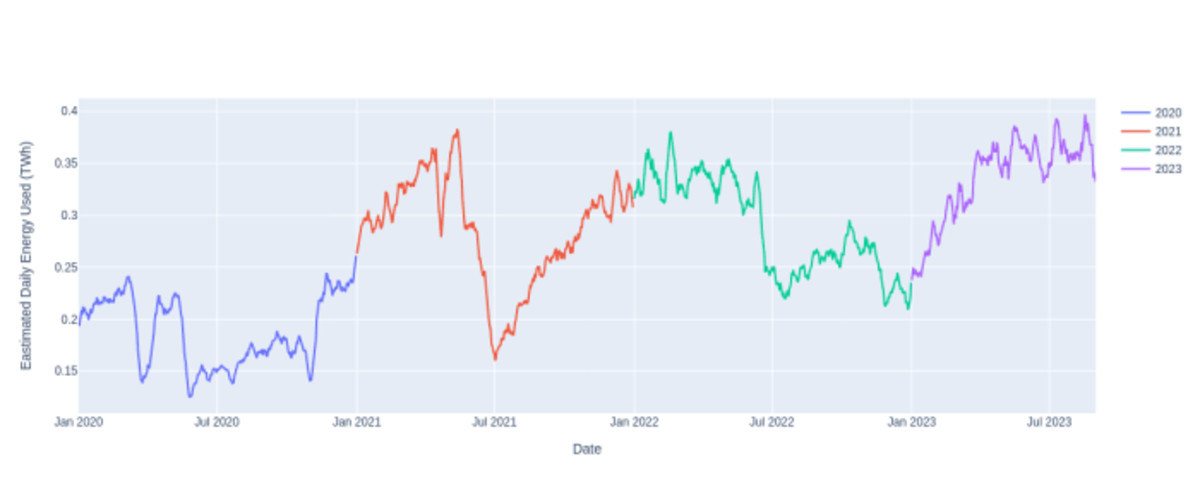
See this multi-colored plot of CBECI’s estimated every day vitality use (TWh) from January 2020 by August 31, 2023? At this macro scale, we see loads of variability. But additionally it’s obvious simply from inspection that every yr is completely different from the following when it comes to variability and vitality use. There are a selection of attainable causes for the reason for variability at this scale. Some attainable influences on vitality use may very well be bitcoin worth, problem adjustment, and machine effectivity. Extra macroscale influences may very well be because of regulation, such because the Chinese language bitcoin mining ban that occurred in 2021. Lots of the Chinese language miners fled the nation for different components of the world, Kazakhstan and america are two international locations the place hashrate discovered refuge. In truth, the ability of the Texas mining scene actually got here to be at this unprecedented second in hashrate historical past.
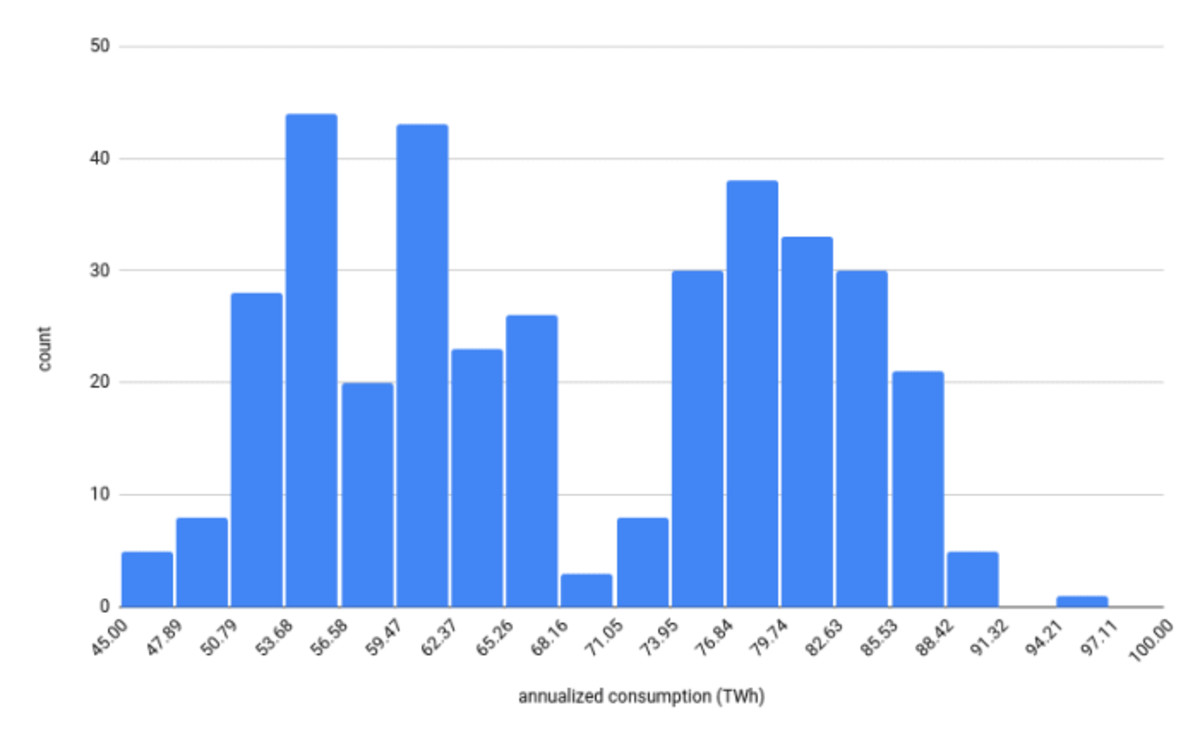

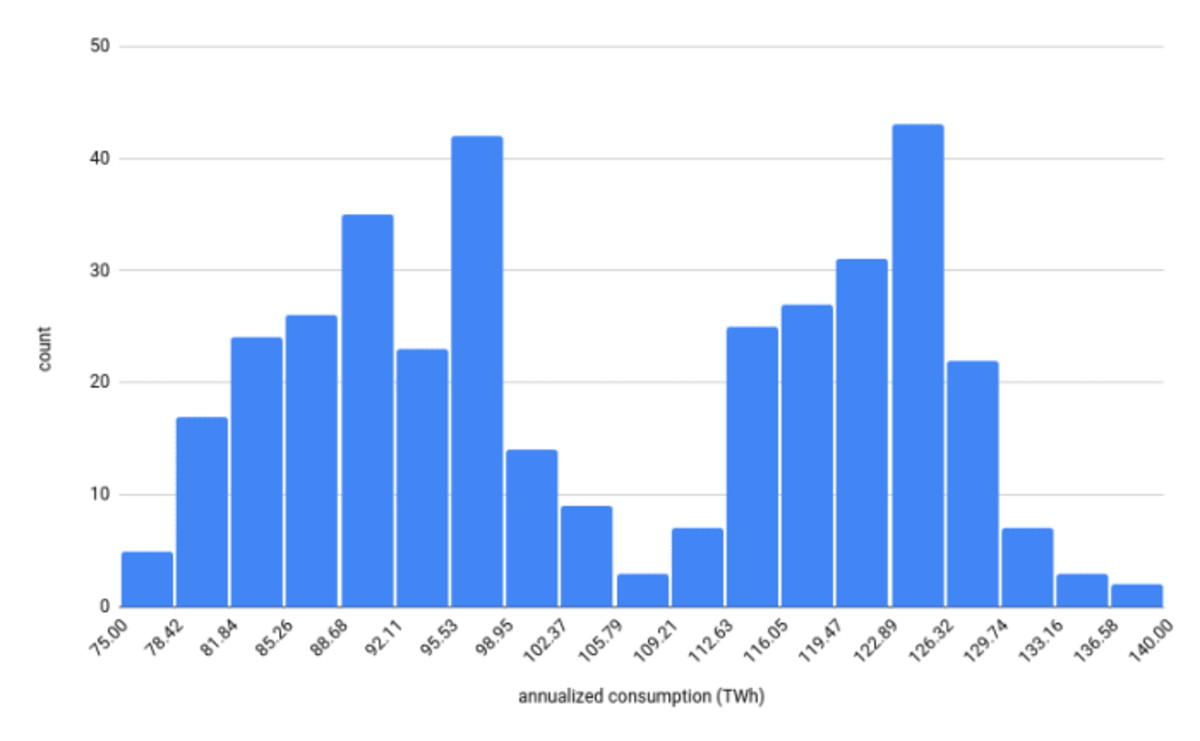
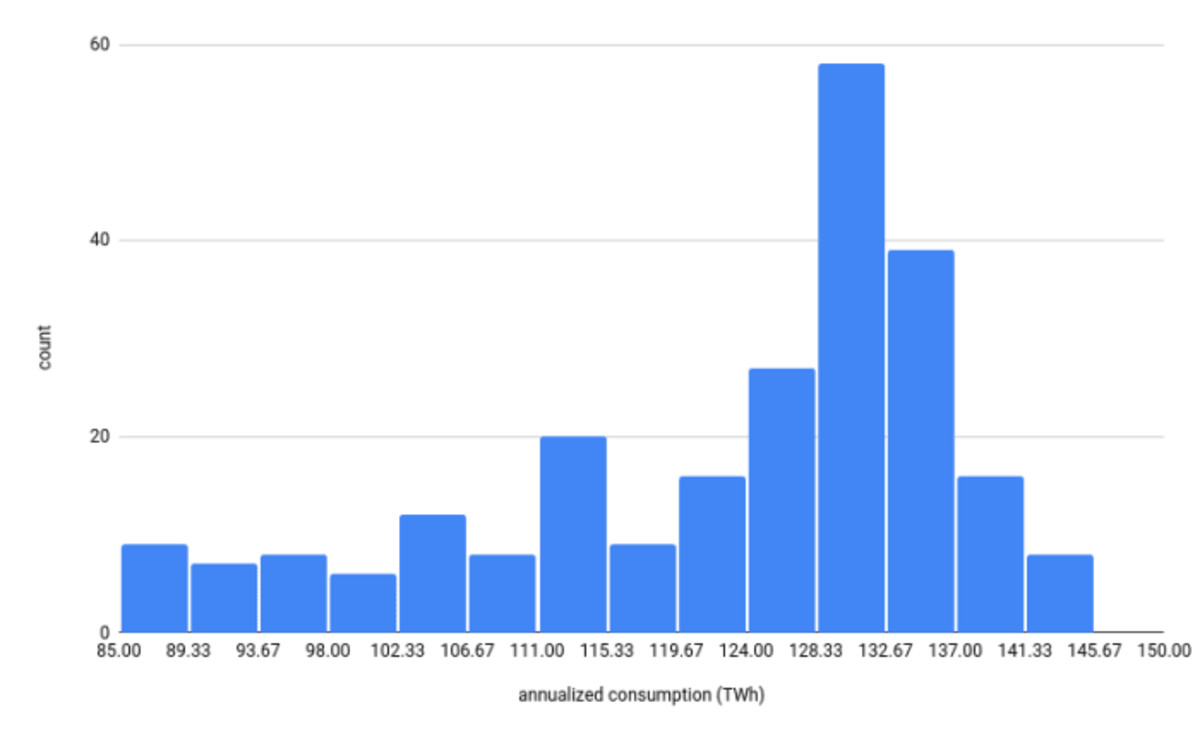
Have a look at the histograms for 2020 (prime left), 2021 (prime proper), 2022 (backside left), and 2023 (backside proper). It’s apparent that for every year, the estimated annualized vitality consumption knowledge exhibits completely different distributions. Although we do see some attainable distribution patterns, we’ve got to watch out to not take this as a sample that occurs each four-year cycle. We want extra knowledge to make certain. For now, what we are able to say is that some years in our evaluation present a bimodal distribution whereas different years present a sort of skewed distribution. The primary level right here is to indicate that the statistics for vitality use for every of those 4 years are completely different, and distinctly so for the 2 years that had been utilized in Chamanara et al.’s evaluation.
Within the UN research, the authors wrote that bitcoin mining exceeded 100 TWh per yr in 2021 and 2022. Nonetheless, if we take a look at the histograms of the every day estimated annualized vitality consumption, we are able to see that every day estimates differ fairly a bit, and even in 2022 there have been many days the place the estimated vitality consumption was beneath 100 TWh. We’re not denying that the ultimate estimates had been over 100 TWh within the older estimated knowledge for these years. As an alternative, we’re displaying that as a result of bitcoin mining’s vitality use will not be fixed from day after day and even minute-to-minute, it’s value doing a deeper evaluation to grasp the origin of this variability and the way it would possibly have an effect on vitality use over time. Lastly, it’s value noting that the up to date knowledge now estimates the annual vitality use to be 89 TWh for 2021 and 95.53 TWh for 2022.
One final remark, Miller et al. 2022 confirmed that operations (particularly buildings) with excessive variability in vitality use over time are typically not appropriate for emission research that use averaged annual emission components. But, that’s what Chamanara et al. selected to do, and what so many of those bullshit fashions are inclined to do. A very good portion of bitcoin mining doesn’t function like a relentless load, Bitcoin mining might be extremely versatile in response to many components from grid stability to cost to regulation. It’s about time that researchers began eager about bitcoin mining from this understanding. Had the authors spent even a modest period of time studying beforehand printed literature, slightly than working in a silo like Sai and Vranken famous of their evaluation paper, they may have at the least addressed this limitation of their research.
—
So, I’ve by no means been to a honky tonk joint earlier than. At the least not till I discovered myself in a taxi cab with a number of different conferencegoers on the North American Blockchain Summit. Fort Price, Texas, is strictly what you’d think about. Cowboy boots, gallon-sized cowboy hats, Wrangler blue denims, and cowboys, cowboys, cowboys all over the place you seemed by the primary drag. On a brisk Friday evening, Fort Price appeared frozen in time, individuals truly walked round at evening. The shops seemed just like the sort of mom-and-pop retailers you’d see on an episode of The Twilight Zone. I felt utterly disoriented.
My companions satisfied me that I ought to discover ways to two-step. Me, your normal California woman, whose physics advisor as soon as advised her that whilst you can take the woman out of California, you possibly can’t take California out of the woman, ought to two-step?! I didn’t know a two-step from an electrical slide and the one nation I bear in mind experiencing was a Garth Brooks business I noticed as soon as on tv after I was a toddler. He was actually fashionable within the nineties. That’s about as a lot nation as this bitcoin mining researcher will get. The place was stuffed with kitschy present retailers and vibrant lights all over the place radiating from neon indicators. On the heart of the primary room, a bartender carrying a black diamond studded belt with a white leather-based gun holster and lined with evenly spaced silver bullets. Who the hell is aware of what sort of gun he was packing, nevertheless it did remind me of the weapons within the 1986 movie, Three Amigos.
It was right here, towards the backdrop of what seemed like a rustic band that wasn’t fully certain that it was nation, that I watched the Texas Blockchain Council’s Lee Bratcher tackle a ball with the sort of trigonometric grace that you possibly can solely discover on the finish of a cue and land that billiard in a tattered, leather-based pocket for what appeared just like the hundredth time that evening. The sleek clank of billiard towards billiard awoke one thing inside me. I spotted that I used to be not but out of the rabbit gap that Frank despatched me down. I remembered someplace scribbled in my notes that I had not plotted the hashrate share over time for the international locations talked about within the UN research. So, at half previous three within the morning, I threw my head again to take a swig of some membership soda and bumped it towards the wall of the picture sales space the place nuclear households might pose with a mechanical bull, and fell unconscious.
Three hours later, I used to be again in my lodge room. Fortunately, somebody positioned some nugatory fiat in my hand, loaded me right into a cab, and had the driving force take me again to the non-smoking room I checked into on the very heart of the decay of twenty-first-century enterprise journey, the Marriott Lodge. Fuzzy-brained and bleary-eyed, I let the blinding, dangerously blue gentle from my pc display wash over my drained face and improve my possibilities of creating macular degeneration. I continued my evaluation.
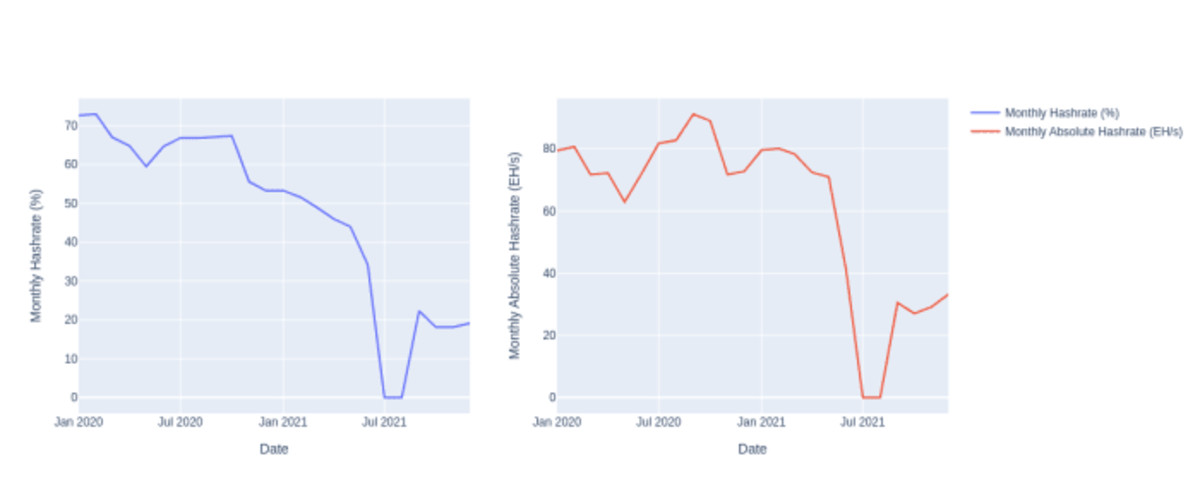
What follows are a collection of plots of CBECI mining map knowledge from January 2020 by January 2022. Unsurprisingly, Chamanara et al. focus consideration on China’s contribution to vitality use, and subsequently to its related environmental footprint. China’s month-to-month hashrate peaked at over 70 % of the community’s whole hashrate in 2020. In July 2021, that hashrate share crashed to zero till it recovered to about 20 % of the share on the finish of 2021. We don’t know the place it stands as we speak, however business insiders inform me it’s probably nonetheless hovering round this quantity, which implies that in absolute phrases, the hashrate remains to be rising there regardless of the ban.
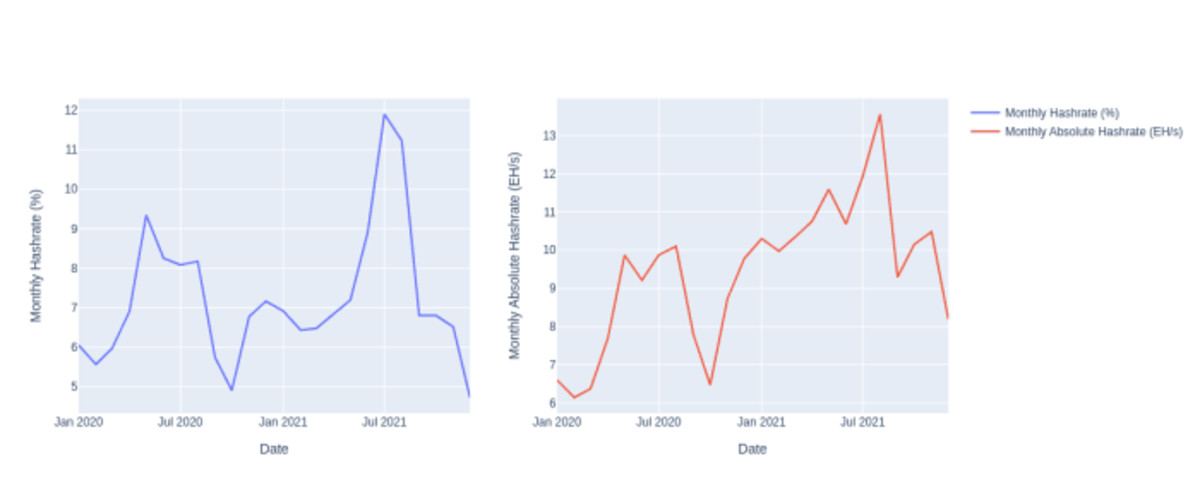
Russia, additionally unsurprisingly, will get mentioned as nicely. But, primarily based on the CBECI mining map knowledge from January 2020 by January 2022, it’s exhausting to argue that Russia was a direct off-taker of exiled hashrate. There’s definitely a direct spike, however is that this actual or simply miners utilizing VPN to cover their mining operation? By the tip of 2021, the Russian hashrate declined to beneath 5 % of the hashrate and in absolute phrases, declined from a quick peak of over 13 EH/s to a bit over 8 EH/s. When wanting on the whole yr’s value of CBECI estimated vitality use for Russia, we do see that Russia did maintain a good portion of hashrate, it’s simply not clear that when working with such a restricted set of information, we are able to make any cheap claims in regards to the current contribution to hashrate and setting footprint for the community.
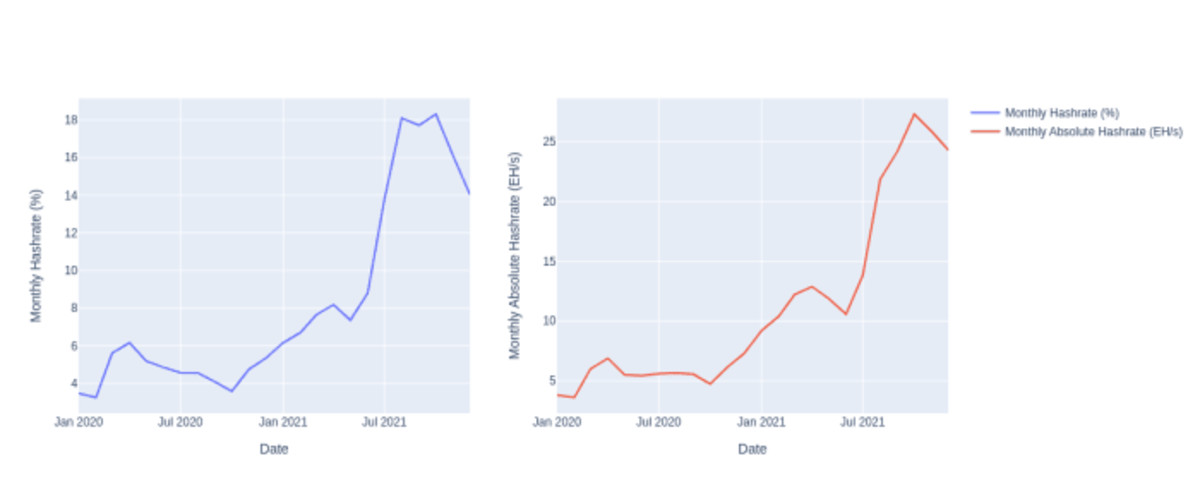
Essentially the most controversial dialogue in Chamanara et al. offers with Kazakhstan’s share of vitality use and environmental footprint. Clearly, the CBECI mining map knowledge exhibits that there was a major improve in hashrate share each in relative and absolute phrases. It additionally seems that this pattern began earlier than the China ban was carried out, however definitely seems to quickly improve simply earlier than and after the ban was carried out. Nonetheless, we do see a pointy decline from December 2021 to January 2022. Was this an early sign that the federal government crackdown was coming in Kazakhstan?
Of their evaluation, Chamanara et al. ignored the current Kazakhstan crackdown, the place the federal government imposed an vitality tax and mining licenses on the business, successfully pushing hashrate in another country. The authors overemphasized Kazakhstan as a present main contributor to bitcoin’s vitality use and thus environmental footprint. If the authors had stayed throughout the limits of their strategies and outcomes, then noting the contribution of Kazakhstan’s hashrate share to the environmental footprint for the mixed years of 2020 and 2021 would have been cheap. As an alternative, not solely do they ignore the federal government crackdown in 2022, however additionally they declare that Kazakhstan’s hashrate share elevated by 34% primarily based on 2023 CBECI numbers. CBECI’s knowledge has not been up to date since January 2022 and CCAF researchers are at present ready for knowledge from the mining swimming pools that may enable them to replace the mining map.
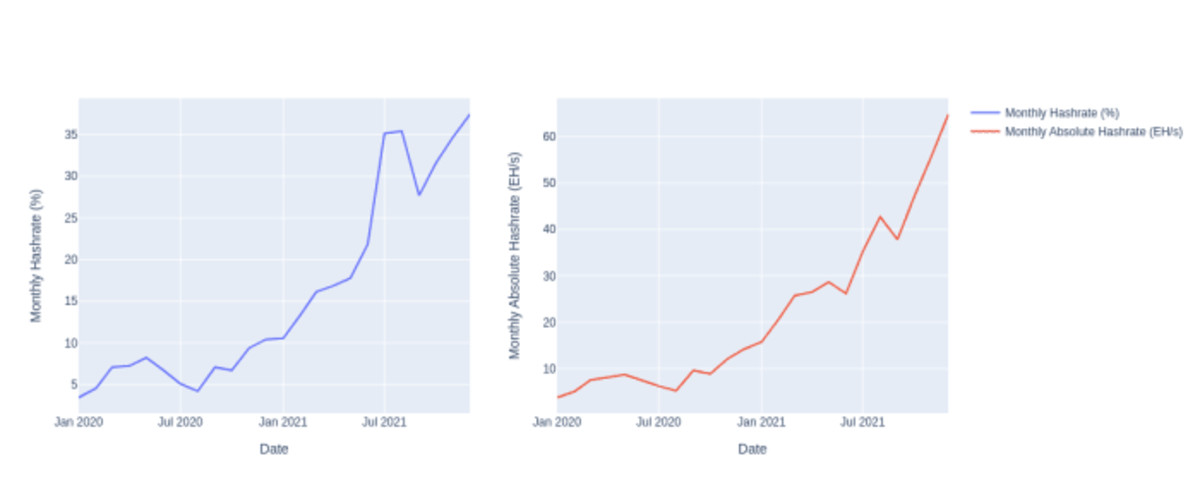
I do know I’ve proven you, my devoted reader, numerous knowledge, however go forward and have one other shot of the toughest liquor you will have in your cupboard, and let’s check out yet one more determine. This one represents america hashrate share within the older CBECI mining map knowledge. The pattern we see for america can be related for Canada, Singapore, and what CBECI Calls “Different international locations”, which symbolize the international locations that didn’t make the highest ten checklist for hashrate share. There’s a transparent sign that displays what we all know to be true. America took a good portion of Chinese language hashrate and this hashrate share grew quickly in 2021. Whereas we all know that the CBECI mining map knowledge is proscribed to lower than a majority of the community hashrate, I do assume that their share is at the least considerably consultant of the community’s geographic distribution. Hashrate geographic distribution appears to be closely formed by macro developments. Whereas electrical energy costs matter, authorities stability and pleasant legal guidelines play an essential position. Chamanara et al. ought to have finished this sort of evaluation to assist inform their dialogue. If that they had, they may have realized that the community is responding to exterior pressures at various occasions and geographic scales. We want extra knowledge earlier than we are able to make sturdy coverage suggestions relating to the results of bitcoin’s vitality use.
—
At this level, I used to be not certain if I used to be a bitcoin researcher or an NPC, misplaced in a recreation the place the one factors tallied had been for the depth of self-loathing I used to be feeling for agreeing to this enterprise. On the similar time, I might odor the tip of this evaluation was close to and that, with sufficient somatic remedy and EMDR, I would truly bear in mind who I was earlier than I obtained dragged into this mess. Simply two days prior, Frank and I had a falling out over whether or not Courier New was nonetheless the perfect font for displaying mathematical equations. I used to be alone on this rabbit gap now. I dug my fingers into the grime partitions surrounding me and slowly clawed my approach again to sanity.
Upon exiting the opening, I grabbed my laptop computer and determined it was time to deal with the research’s environmental footprint methodology, wrap up this pet, and put a bow on it. Chamanara et al. claimed that they adopted the strategies utilized by Ristic et al. (2019) and Obringer et al. (2020). There are a number of explanation why their environmental footprint method is flawed. First, the footprint components are usually used for assessing the environmental footprint of vitality era. In Ristic et al., the authors developed a metric known as the Relative Aggregated Issue that included these components. This metric allowed them to judge the position of latest electrical energy turbines like nuclear or offshore wind. The thought behind this method was to be conscious that whereas carbon dioxide emissions from fossil fuels had been the primary driver for creating vitality transition objectives, we also needs to keep away from changing fossil gas era with era that would create environmental issues in several methods.
Second, Obringer et al. used lots of the components listed in Ristic et al. and mixed them with community transmission components from Aslan et al. (2018). This was a foul transfer as a result of Koomey is a co-author on this paper, so it shouldn’t be stunning that in 2021, Koomey co-authored a commentary alongside Masanet the place they known as out Obringer et al. In Koomey and Masanet, 2021, the authors chided the idea that short-term adjustments in demand would result in instant and proportional adjustments in electrical energy use. This critique may be utilized to Chamanara et al., which checked out a interval when bitcoin was experiencing a run-up to an all-time excessive in worth throughout a novel financial setting (low rates of interest, COVID stimulus checks, and lockdowns). Koomey and Masanet made it clear of their commentary that ignoring the non-proportionality between vitality and knowledge flows in community tools can yield inflated environmental-impact outcomes.
Extra importantly, we’ve got but to characterize what this relationship seems to be like for bitcoin mining. Demand for conventional knowledge facilities is outlined by the variety of compute situations wanted. What’s the equal for bitcoin mining after we know that the block measurement is unchanging and the block tempo is adjusted each two weeks to maintain a mean 10-minute spacing between every block? This deserves extra consideration.
Both approach, Chamanara et al. didn’t appear to concentrate on the criticisms of Obringer et al.’s method. That is actually problematic as a result of as talked about at the beginning of this screed, Koomey and Masanet laid the groundwork for knowledge heart vitality analysis. They need to have recognized to not apply these strategies to bitcoin mining as a result of whereas the business has variations from a conventional knowledge heart, it’s nonetheless a kind of information heart. There’s quite a bit that bitcoin mining researchers can take from the torrent of information heart literature. It’s disappointing and exhausting to see papers printed that ignore this actuality.
What extra can I say aside from this shit has to cease. Brandolini’s Regulation is actual. The bullshit asymmetry is actual. I really need this new halving cycle to be the one the place I not have to deal with dangerous analysis. Whereas I used to be penning this report, Alex de Vries printed a brand new bullshit paper on bitcoin mining’s “water footprint”. I haven’t learn it but. I’m unsure that I’ll. But when I do, I promise that I can’t write over 10,000 phrases on it. I’ve said my case and made my peace with this style of educational publishing. It was a enjoyable experience, however I believe it’s time to observe some self-care, deal with myself to a number of evenings of wholesome binge-watching, and dream of the ineffable.
—
In the event you loved this text, please go to btcpolicy.org the place you possibly can learn the complete 10,000-word technical evaluation of the Chamanara et al. (2023) research.
It is a visitor submit by Margot Paez. Opinions expressed are fully their very own and don’t essentially replicate these of BTC Inc or Bitcoin Journal.








